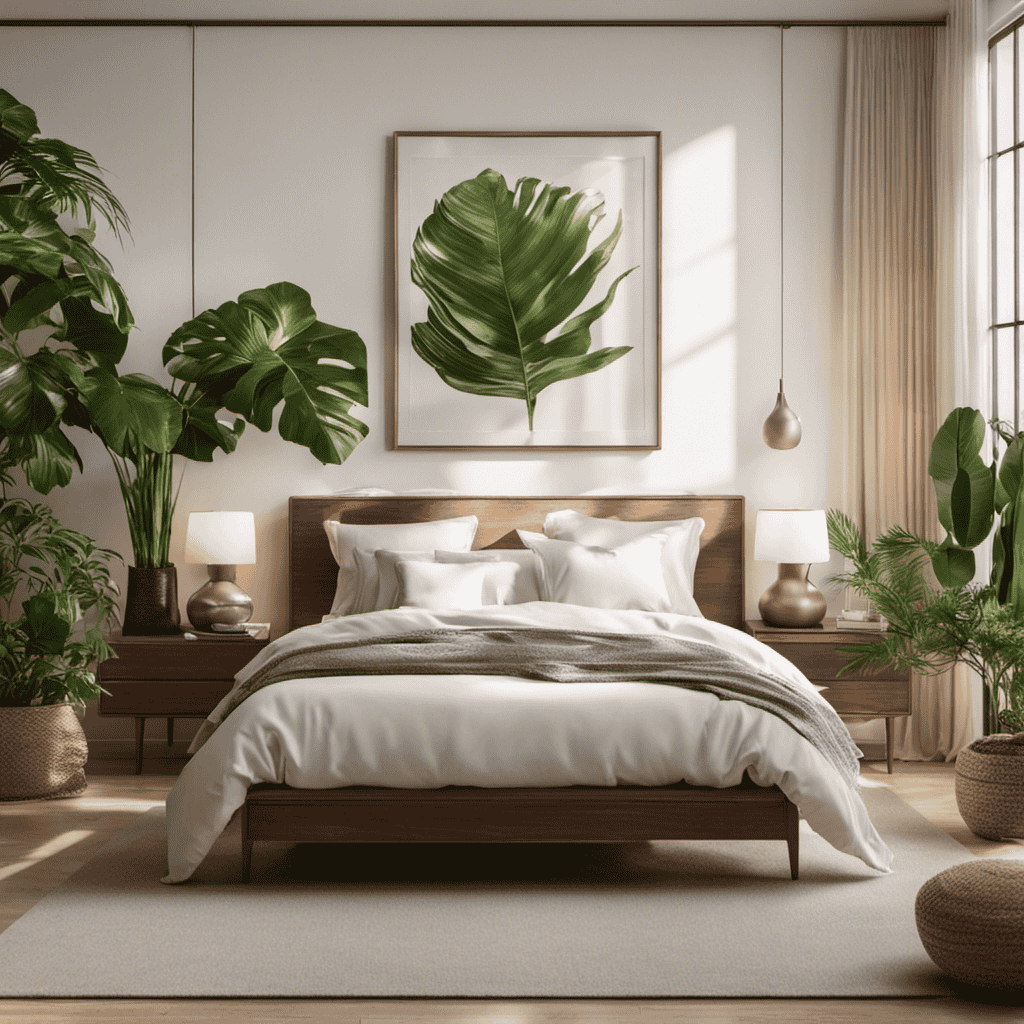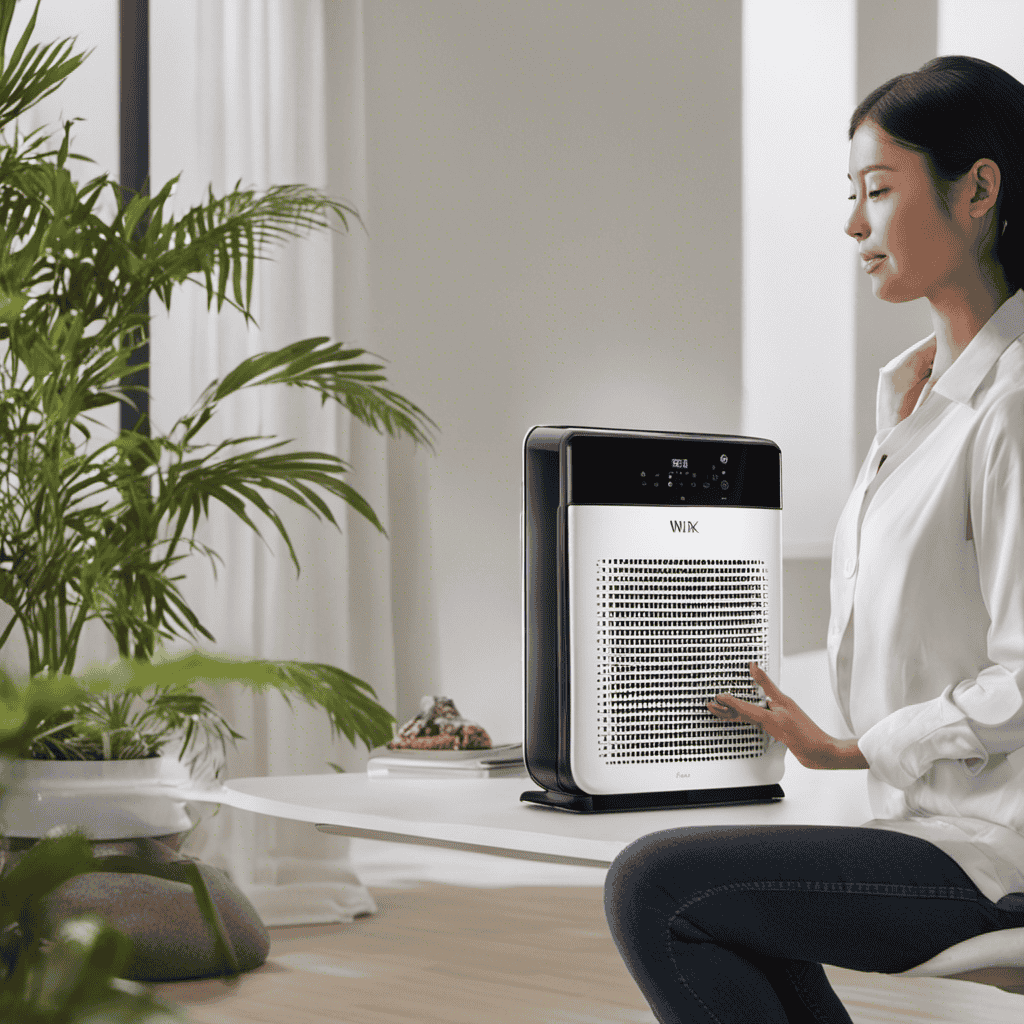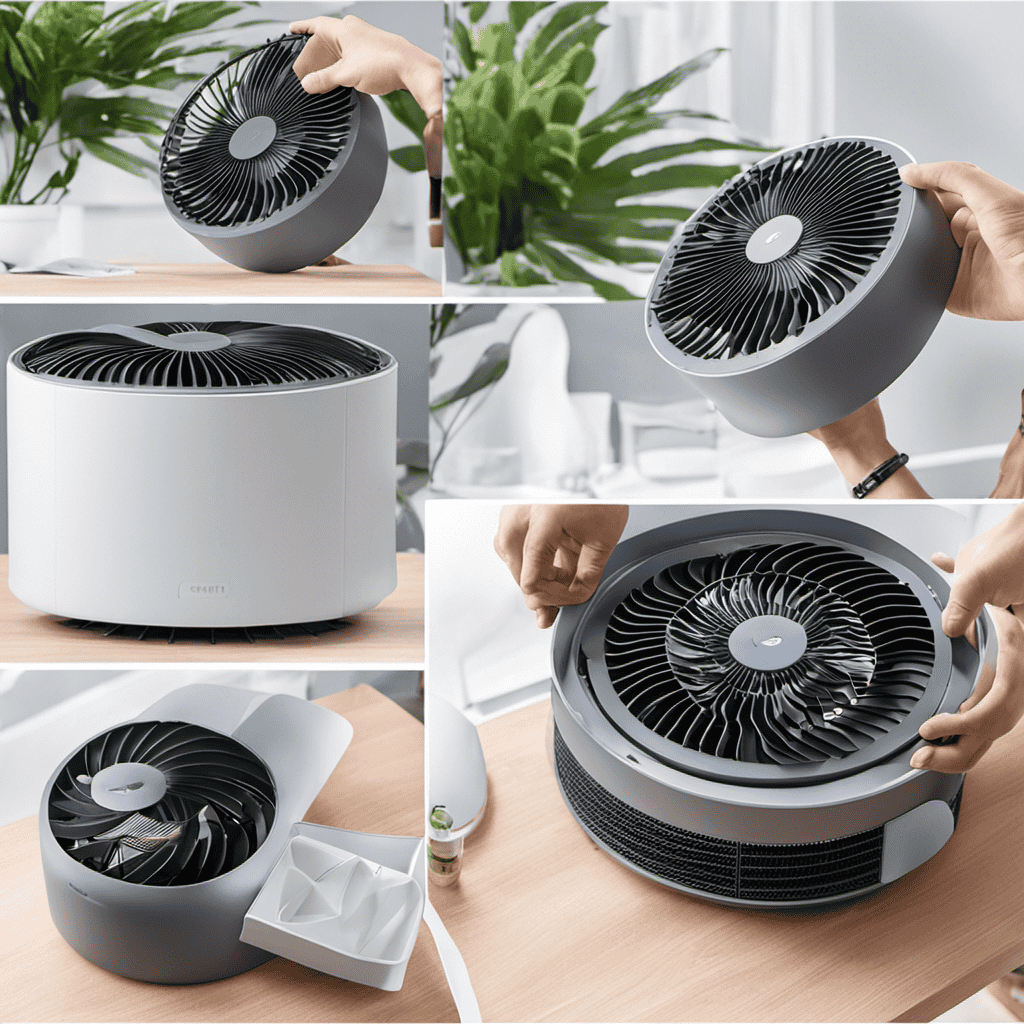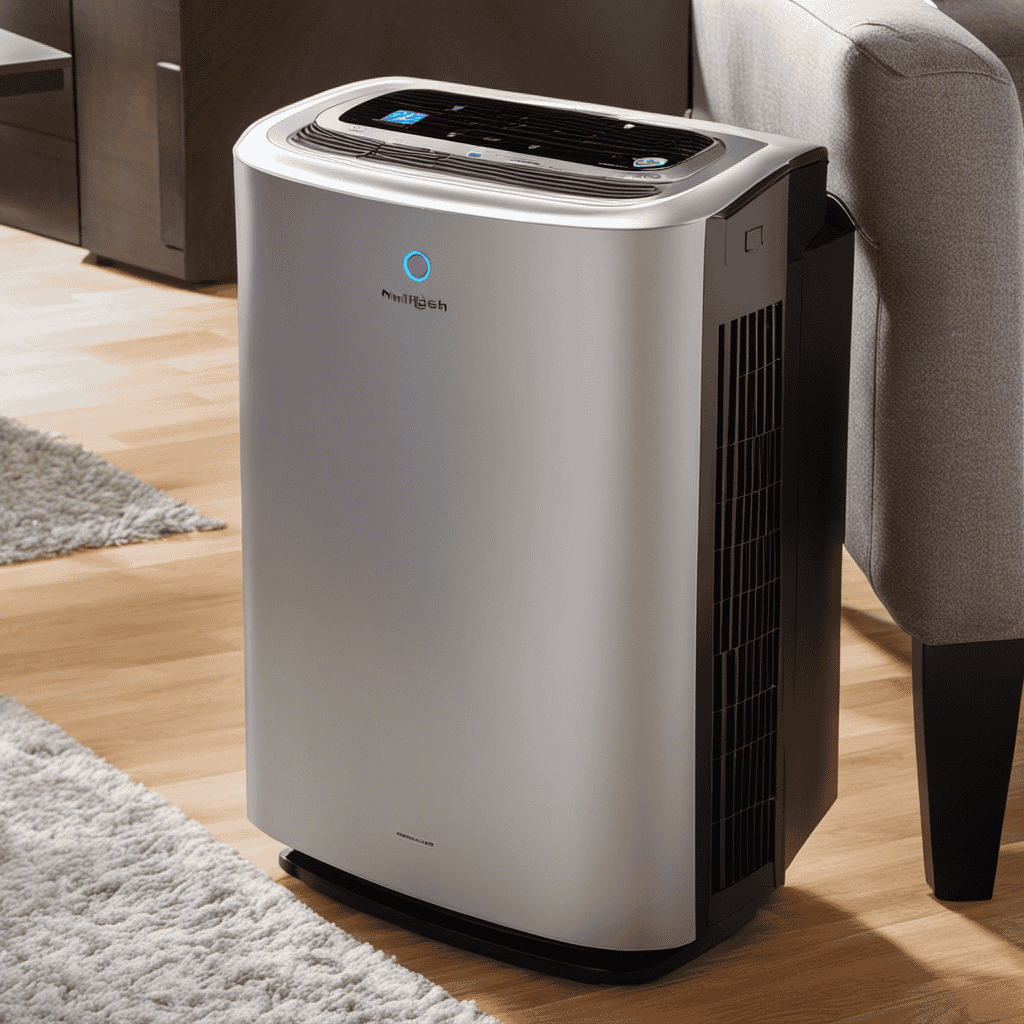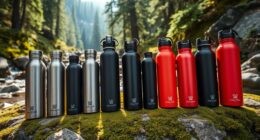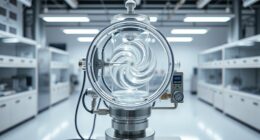To keep your air purifier working at peak performance, regularly check and replace filters according to the manufacturer’s schedule. Clean the exterior and vents to prevent dust buildup, and inspect sensors for proper operation, calibrating or replacing them if needed. Confirm the device is placed on a stable, unobstructed surface away from walls and electronics. Maintaining surrounding space clear and performing routine system checks will help maximize efficiency—keep going to discover detailed tips that make the process easier.
Key Takeaways
- Regularly check and replace filters and sensors to maintain air quality and device efficiency.
- Clean exterior surfaces and vents to prevent airflow blockages and dust buildup.
- Properly position the purifier on a stable surface, away from obstructions, for optimal performance.
- Conduct routine system checks, calibrate sensors, and verify indicator lights for accurate operation.
- Ensure surrounding environment is tidy, with unobstructed airflow and no objects blocking vents.
Check and Replace Filters Regularly

Regularly checking and replacing your air purifier’s filters is essential for maintaining ideal performance. Over time, filters reach the end of their lifespan, reducing their ability to effectively remove allergens from the air. If you neglect to replace them, your purifier can become less efficient, letting allergens like dust, pollen, and pet dander circulate freely. To guarantee maximum allergen removal, follow your manufacturer’s recommendations for filter replacement intervals. Keep an eye on indicator lights or check the filter’s condition periodically. Regular replacements not only improve air quality but also extend your device’s lifespan. Don’t wait until your air feels stuffy or allergy symptoms worsen—timely filter changes keep your air purifier functioning at its best.
Clean the Exterior and Vents

To keep your air purifier working efficiently, start by wiping down the outer surface with a soft cloth to remove dust and fingerprints. Next, clear out dust from the vents to prevent airflow blockages. Use a gentle, damp cloth to make certain all surfaces stay clean without causing damage. Regularly inspecting and cleaning the filters ensures optimal filtration performance and prolongs the device’s lifespan. Additionally, checking the filter replacement schedule helps maintain peak efficiency and air quality. Ensuring proper airflow by avoiding obstructions around the unit can also enhance overall performance. Incorporating regular maintenance checks can help identify potential issues early and prevent malfunctions, ensuring your air purifier operates smoothly. Proper maintenance also minimizes the chances of encountering malfunctions and keeps the device operating smoothly.
Subheading 1: Wipe Down Outer Surface
Cleaning the exterior and vents of your air purifier is a simple but essential step to keep it functioning effectively. Regular wiping prevents dust buildup that can reduce air quality and increase noise levels. Use a soft cloth to wipe the outer surface and vents gently. Keep in mind, a clean exterior helps the purifier operate quietly and efficiently. Here’s a quick guide:
| Task | Tips |
|---|---|
| Wipe the outer surface | Use a damp cloth, avoid harsh chemicals |
| Clean the vents | Dust removal brush or microfiber cloth |
| Check for dust buildup | Regular inspection ensures *ideal* performance |
Staying proactive with exterior cleaning ensures your air purifier maintains peak performance, providing better air quality and quieter operation. Regularly inspecting and maintaining the filters also contributes significantly to overall efficiency. Additionally, understanding industry transformations related to AI automation can help you choose models with advanced features for optimal performance. Proper maintenance not only extends the lifespan of your device but also ensures it continues to operate at peak efficiency.
Subheading 2: Clear Vents of Dust
Since dust can quickly accumulate on your air purifier’s vents and exterior, it’s important to remove it regularly to maintain ideal airflow and performance. Dust buildup on vents can cause obstructions that reduce efficiency and strain the device. Use a soft, damp cloth or a gentle brush to wipe away dust from the vents and outer surface. Be sure to reach into any crevices or slats where dust might hide. Avoid using harsh cleaners or abrasive tools that could damage the surface. Regular cleaning prevents vent obstructions, ensuring your air purifier operates smoothly and effectively. Keeping vents clear also helps prolong the lifespan of the unit and maintains excellent air quality in your space. Incorporating routine maintenance into your schedule can help keep your air purifier functioning at peak performance. Additionally, inspecting for signs of wear or damage on the electrical components can help prevent potential safety issues, especially since some models include advanced smart capabilities. Regularly checking for dust accumulation on internal filters and components can further enhance performance and air quality, which is essential for optimal air purification.
Subheading 3: Use Soft Cloth
After removing dust from the vents and exterior with a soft brush or damp cloth, it’s important to maintain that cleanliness regularly. Soft cloth cleaning and gentle wiping prevent scratches and keep your air purifier looking new. Use a microfiber or cotton cloth to avoid leaving lint behind. When cleaning the exterior and vents, avoid harsh chemicals that could damage surfaces. Regularly wipe down the vents to prevent dust buildup, which can hinder airflow. Keep the exterior free of smudges and dirt to guarantee ideal operation. For stubborn spots, dampen the cloth slightly, then wipe gently. Remember, consistent soft cloth cleaning extends the life of your device and keeps it functioning efficiently. Incorporating proper maintenance practices helps ensure your air purifier continues to operate at optimal efficiency. Additionally, paying attention to privacy and data security when using online manuals or troubleshooting guides can protect your personal information. Regular cleaning also supports the device’s filter performance, ensuring cleaner air output. To further enhance your device’s longevity, consider routine inspections to catch potential issues early. Also, inspecting the internal components periodically can help identify any signs of wear or damage before they become major problems.
Inspect and Replace Sensors When Needed

Regularly inspecting your air purifier’s sensors guarantees they function accurately and maintain ideal air quality. Over time, sensors can drift, requiring sensor calibration or sensor replacement to ensure *best* performance. Check for signs of malfunction, such as inconsistent readings or error messages. If needed, calibrate sensors following the manufacturer’s instructions or replace them entirely. Here’s a quick visual guide:
| Sensor Type | Signs of Malfunction | Action Required |
|---|---|---|
| Air Quality Sensor | Faulty readings, errors | Sensor calibration or replacement |
| Humidity Sensor | Inaccurate humidity levels | Sensor replacement |
| CO2 Sensor | No response or lag | Sensor replacement |
| Particulate Sensor | Excessive dust detection issues | Sensor calibration |
| VOC Sensor | Persistent false alarms | Sensor replacement |
Maintaining sensors properly helps prevent performance degradation and prolongs the lifespan of your air purifier. Ensuring proper sensor calibration is essential for accurate detection and efficient operation, especially as sensors age. Proper sensor maintenance also helps identify early signs of malfunction, preventing unexpected device failure. Regular sensor testing can help catch issues before they impact air quality. Keeping sensors in top shape ensures your air purifier works efficiently. Proper maintenance also reduces vulnerabilities that could be exploited by malicious actors, aligning with ongoing efforts in AI security to ensure trustworthy technology.
Ensure Proper Placement and Stability
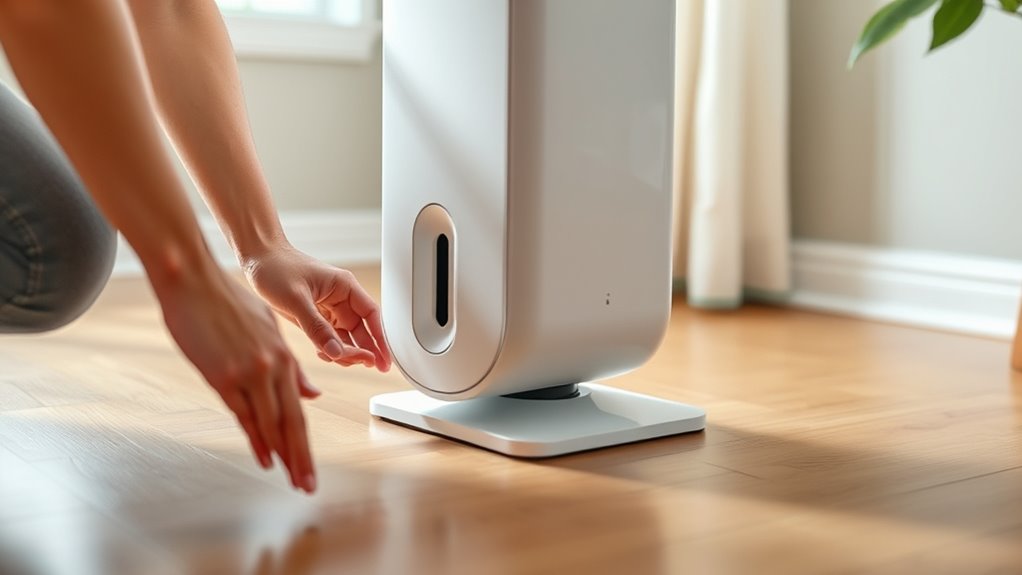
You need to place your air purifier on a stable, level surface to guarantee it works effectively. Avoid placing it on uneven or wobbly furniture, which can cause it to tip or shift. Proper placement not only improves performance but also keeps the unit secure and safe. Ensuring the proper positioning of essential oils can also enhance the air purifier’s effectiveness in maintaining a healthy environment. Additionally, understanding local building codes and permits ensures that your installation complies with safety standards, preventing potential issues. Incorporating spiritual practices benefits from related crafts can also help in maintaining the longevity of your device and accessories. Being mindful of environmental health considerations can further optimize your air quality.
Placement Matters
Proper placement is key to maximizing your air purifier’s effectiveness. When you position it correctly, you improve air quality and keep noise levels manageable. Place your purifier in a central location, away from walls or furniture that block airflow. Keep it at least a few feet off the ground for ideal circulation. Avoid placing it near electronics or sources of noise that could increase noise levels. Guarantee unobstructed airflow by not blocking vents or filters. Regularly check that it’s stable to prevent tipping or vibrations that could reduce performance.
- Position in a central, open area
- Keep at least 3 feet away from walls
- Elevate it on a stable surface
- Avoid placing near electronics
- Guarantee it’s on a flat, stable surface
Stable Surface Assurance
Ensuring your air purifier is on a flat, stable surface is essential for ideal performance. Proper surface stability prevents vibrations and accidental tipping, which can disrupt device placement. When setting up your air purifier, choose a sturdy, level surface away from clutter, curtains, or furniture that could obstruct airflow. Secure placement ensures the device stays steady during operation, minimizing noise and maintaining optimal efficiency. Avoid placing your purifier on uneven or wobbly surfaces, as unstable positioning can damage internal components or cause it to fall. Regularly check that the surface remains stable, especially if you move furniture or the environment changes. Proper device placement on a stable surface guarantees consistent airflow and helps your air purifier work at peak performance.
Perform Routine System Checks and Calibration

Regularly performing system checks and calibration is essential to maintaining your air purifier’s ideal performance. Proper calibration ensures sensors accurately detect air quality, while checking filter lifespan helps prevent unexpected failures. You should:
- Test sensor responsiveness and recalibrate if readings seem off
- Inspect filters for signs of wear or dirt buildup
- Confirm filter replacement dates and change filters as needed
- Verify that indicator lights accurately reflect system status
- Clean sensor areas to prevent dust interference
These steps help keep your air purifier functioning efficiently and extend its lifespan. Regular calibration and system checks catch issues early, ensuring your device continues to deliver clean air. Staying proactive prevents costly repairs and maintains excellent air quality in your space.
Keep the Area Around Your Purifier Clear
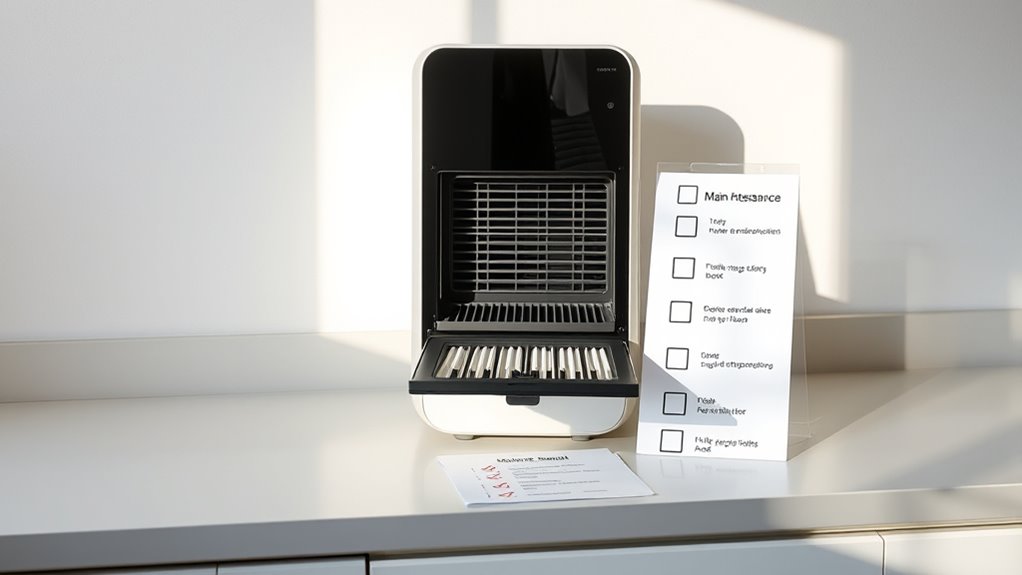
Have you considered how clutter around your air purifier can impact its performance? If objects block airflow or accumulate dust, your purifier can’t operate efficiently, reducing its ability to improve air quality and allergen reduction. Keep the area around your device tidy and free of obstructions, ensuring air can circulate freely. Avoid placing objects directly on top of or too close to the intake or exhaust vents. Regularly vacuum or dust nearby surfaces to prevent dust buildup that could be pulled into the purifier. A clear space allows your air purifier to work at peak efficiency, capturing more airborne pollutants and allergens. By maintaining an uncluttered environment, you maximize its lifespan and ensure you breathe cleaner, healthier air every day.
Frequently Asked Questions
How Often Should I Schedule Professional Maintenance for My Air Purifier?
You should schedule professional service for your air purifier at least once a year to guarantee it runs at its best. Following a regular maintenance schedule helps prevent issues and maintains air quality. If you notice decreased performance or unusual noises, consider more frequent check-ups. Staying consistent with your maintenance schedule keeps your purifier functioning efficiently, extends its lifespan, and ensures you breathe clean air always.
Can I Use Any Cleaning Solutions on the Purifier’S Sensors or Filters?
Like a Swiss Army knife in your toolkit, your air purifier’s sensors and filters need proper care. You can’t just use any cleaning solutions; stick to manufacturer-recommended cleaning solutions to avoid damage. Check sensor compatibility before cleaning, as some solutions may harm sensitive parts. Using inappropriate cleaning solutions risks impairing your device’s efficiency. Always follow the user manual to keep your air purifier running smoothly and effectively.
What Are Signs That My Air Purifier Needs Urgent Repairs?
If your air purifier shows signs of sensor malfunction or if the filter discoloration worsens unexpectedly, it’s time to seek urgent repairs. You might notice reduced airflow, strange noises, or persistent odors despite cleaning. These issues indicate that your device isn’t functioning properly and may have internal damage. Ignoring these signs can compromise air quality, so address them promptly to guarantee your purifier continues to protect your space effectively.
How Does Air Purifier Placement Affect Its Overall Efficiency?
Think of your air purifier as a lighthouse guiding clean air into your space. Proper placement is key to airflow optimization and room size compatibility. Keep it away from walls and obstructions to prevent airflow blockages, ensuring it works efficiently. Position it centrally in the room for even coverage, and avoid corners where airflow is limited. This strategic placement maximizes its effectiveness, giving you fresh, purified air all around.
Are There Specific Environmental Conditions That Can Harm My Air Purifier?
Environmental conditions can substantially impact your air purifier’s performance. High humidity levels may cause mold growth or damage filters, reducing efficiency. Chemical exposure from fumes or cleaning products can clog filters and compromise air quality. To keep your air purifier working at its best, avoid placing it in damp areas, and minimize exposure to strong chemicals. Proper placement and avoiding harsh environments ensure your purifier maintains peak performance and keeps your air clean.
Conclusion
By sticking to this maintenance checklist, you’ll keep your air purifier running smoothly and efficiently. Regular upkeep not only prolongs its lifespan but also guarantees cleaner, healthier air in your space. Remember, “A stitch in time saves nine”—addressing small issues early prevents bigger problems later. Stay consistent with these simple steps, and your purifier will continue to serve you well, providing fresh air whenever you need it most.



